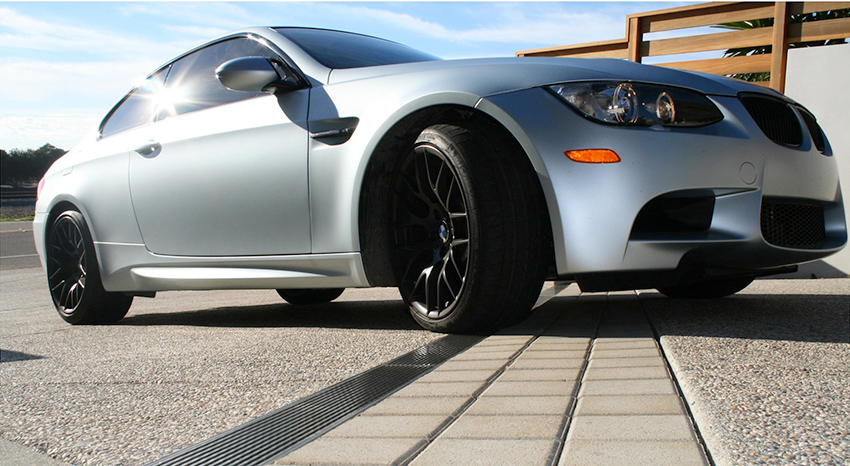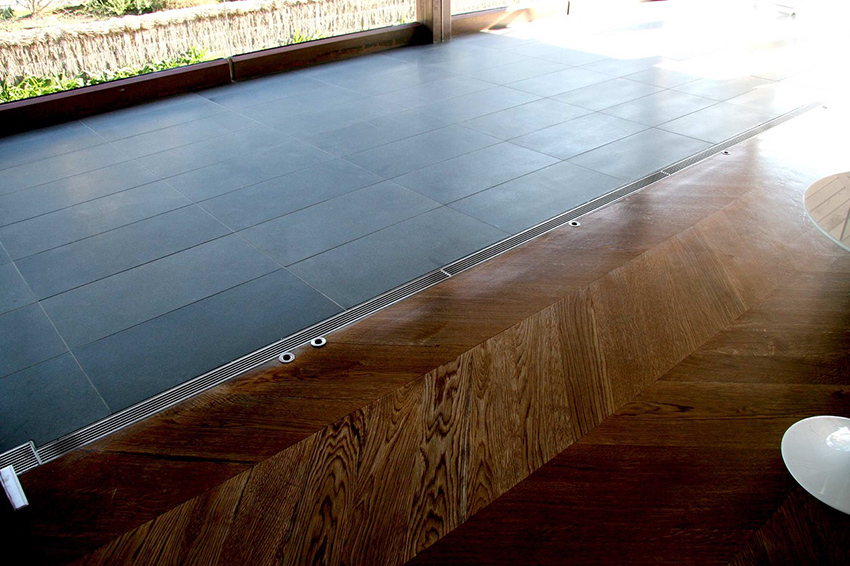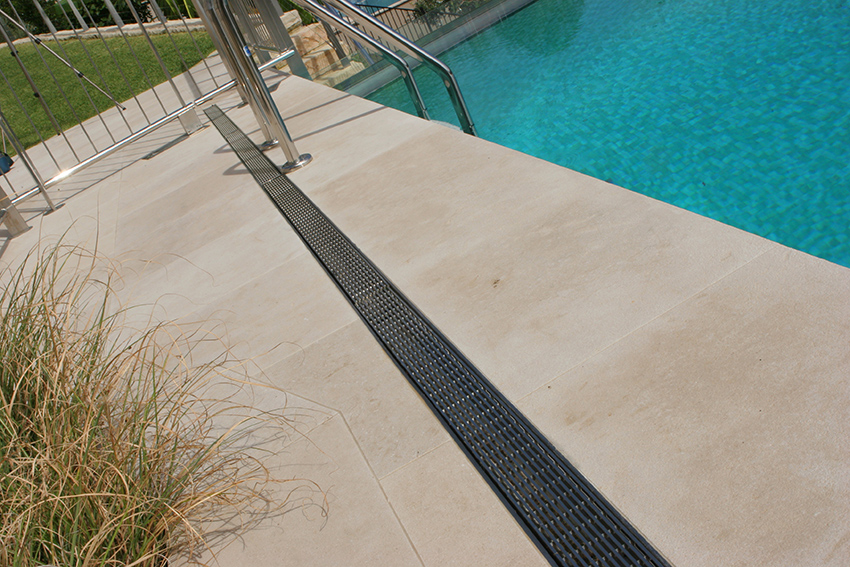Architectural Linear Drains for Indoor and Outdoor Use
Driveways for Vehicular Traffic
Pavement of different types are the norm for vehicles to travel or park upon. Most often, that pavement is impervious to water penetration, which means that rainwater collects and pools across the entire paved surface. Just like walkways, the pavement for vehicles is typically sloped gently to direct water to the edges or to a central location where it can drain across the surface to unpaved areas or into an underground stormwater collection system.
In some design situations, the paved area is close to buildings and the paving creates a featured area – such as a combined courtyard and parking area, for example. In such cases, the design of the pavement and the surroundings is meant to convey a higher level of design such that utilitarian approaches to drainage don’t match the intent. There is likely the need to have drainage in these cases, not only to prevent water from ponding, but also to protect the building so water doesn’t seep into or penetrate at the foundation. In these cases, carefully sloping the paving away from the building and collecting the water with a linear architectural drain can be ideal. The linear appearance can integrate nicely with a paving pattern and even help reinforce a delineation of space. The selection of the grate in this case obviously needs to take into account the added strength needed, which likely means a heavier gauge of stainless steel will be appropriate. The outlets can be vertical or horizontal depending on the nature of the piping that it is feeding into.

Photo courtesy of Infinity Drain
Architectural drainage used in outdoor paved areas can be readily designed to accommodate vehicular traffic and alleviate drainage issues in parking and driving areas.
Balconies
Many residential, hospitality, and commercial buildings incorporate exterior balconies into their design. Those balconies are subject to all of the same weather and drainage issues as are found on the ground. This can be particularly noteworthy when the building is located in an area that is prone to frequent heavy rains or snow accumulation that needs to drain away when it melts. When there are multiple balconies aligned above each other, it often becomes impractical to simply allow the water to drain down onto balconies below without any other means of managing the drainage. In some cases, a collection system may be used along the edge in the style of a gutter and downspout or scupper, but that can quickly become problematic from a design perspective or difficult to maintain on the part of the owner.
A more coordinated solution to proper drainage on balconies is to use architectural linear drains along or near the outer edge. By slightly sloping the balcony surface away from the building and towards the edge of the balcony, water is directed to a drain where it can be collected and piped away. If the linear drain is not located at the very edge of the balcony, then that edge can be tipped gently back toward the linear drain to prevent water from dripping down. The drain piping that the linear drain feeds into can be concealed within the balcony floor assembly and lead to a separate vertical drain. That vertical drain can outlet at the ground or tie into an underground stormwater system as may be appropriate.

Photo courtesy of Infinity Drain
Balconies require management of water, too, which can be provided, as shown above, with a continuous linear drain near the edge to collect and remove water.
Drainage For Outdoor Spaces
Beyond outdoor spaces designed for moving through, there are plenty of residential and commercial spaces that are intended for people to use and linger in. Those can be large or small but often include a finished surface of some type that requires attention to the management of water there as well. Some common conditions are as follows.
Decks and Patios
Many buildings are designed to include decks and patios. There seems to be a growing trend to cover those surfaces with a solid material, such as ceramic tile or a similar nonporous surface. Similarly, there are occasions where different materials are abutted next to each other and need some attention to detail. In all these cases, drainage needs to be a part of the overall design since water is not typically allowed to drain down between gaps in decking materials as on wood board decks.
For these more upscale approaches to decks and patios, architectural linear drains provide an ideal solution. The ability to integrate them into a design layout, between different materials or along edges, means that the surfaces can retain their design appeal while the linear drain takes care of draining away the water.

Photo courtesy of Infinity Drain
Decks and patios covered with tile or solid, continuous surfaces benefit from the design integration of architectural linear drains.
Outdoor Kitchens
A growing trend, especially for high-end residential work, is to include an outdoor kitchen and eating area. Often those are partly or mostly covered with a roof, but not always. If this feature is part of a design project, then the outdoor floor surface should be assessed for drainage needs. In some cases, the appropriate solution may be to slope everything away from the building, but in others, that may not be possible or practical.
Linear drains can be part of the solution here, especially if the outdoor kitchen area is immediately adjacent to the building. Providing a linear drain between the exterior wall and the floor surface of the kitchen helps to keep water outside and away from wall and floor assemblies.

Photo courtesy of Infinity Drain
Outdoor kitchen and eating areas immediately adjacent to buildings are well served by drains along the edge of the building.
Outdoor Pool Areas
Outdoor swimming pools are popular in most hospitality projects and many residential ones (both single and multifamily). Here, the water is quite desirable – but only when it is inside the pool. There are plenty of ways that water can overflow the pool due to heavy rainfall or from splashing activities. Then, the areas around the pool become a focus of concern because wet, slippery conditions can occur that increase exposure to liability for the owner.
A common and well-accepted means of controlling the errant pool water is to run linear architectural drains around the perimeter of the pool – or at least any areas where people are walking. The location may vary based on the design of the pool and the area around it, but, generally, locating drains a few feet from the pool edge allows for water to land from splashing but remains close enough to contain any overflow as well. There may also be practical limits based on the pool construction as to how close a drain can be located. Regardless, the drain can also be used to delineate the pool edge and serve as a visual safety reminder, particularly for young children. The water can then drain back to the pool filtration system or be carried away as appropriate.

Photo courtesy of Infinity Drain
Linear drains around outdoor swimming pools can make the area safer in an attractive and effective way.










